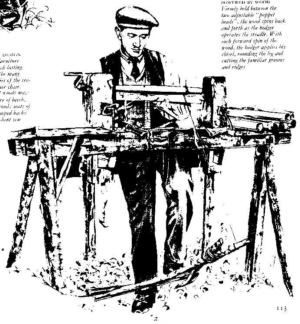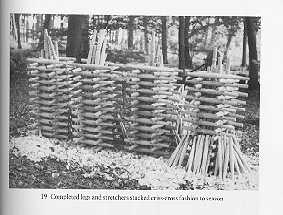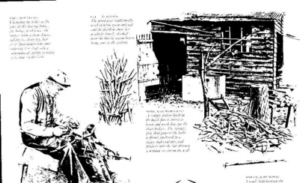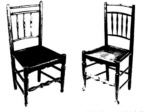OLD
TIME CHAIRS
THE
HISTORY OF CHAIR MAKING IN BISHOP`S CASTLE &CLUN
SOUTH
SHROPSHIRE HILLS
e-mail:chairs@oldtime.co.uk
The Clun Forest was a
chairmaking area for hundreds of years until factory production
and changes of fashion forced the last chairmakers out of
business just before the turn of the last century.
Coppiced ash would be
felled and cleaved in the woods in the autumn and winter by men
working in pairs. Together they would fell the coppiced ash
trees, cut the logs to size and cleave them - splitting them down
the grain. This splitting, as logs would do naturally in time,
releases the tension in the wood. This means the wood is
unstressed and therefore does not warp as it dries. It shrinks
back on itself.
One man would use a
shaving horse and a draw blade, one of the oldest know tools, to
take the edges off the cleft quarters before giving them to the
other man on the pole lathe, an ancient tool first used by the
Egyptians, to produce legs, stretchers, spindles and seat rails
for the chairs.
 |
The wood to
be turned is firmly held between the poppet heads. The
wood spins back and forth as the bodger operates the
treadle. With each foreard spin of the wood, the bodger
applies his chisel rounding the leg and cutting the
familiar grooves and ridges. Because green wood is softer
to work, it is possible to work a hard wood like ash in
this way.
This picture
was reproduced with permission from Emblem, publishers of
The International Book of Wood.
|
In the earliest days the
chairs would probably have been finished in the woods, with the
seats being made of bark strips or rushes (segs) from the River
Clun. But once the market towns of Bishop`s Castle and Clun had
sawpits, plank seats could be made and fitted in town workshops.
The chair pieces,seasoned during the summer by being left in airy
stacks or threaded through hedges, would be brought down to the
town chair makers.

|
A stack of
legs and stretchers left in the woods to
"season" over the summer.
|
Some times the pole lathe
would be inside a make shift shed with the pole through the glass
less window so work could carry on in bad weather.

In the towns the chair
makers would re-turn the ends of the stretchers and spindles -
they would have ovalled as they dried - and make the chairs
without glue. The pieces were fitted so that any shrinking of the
wood (by the thicker pieces which hadn't dried out completely)
would tighten the joints. They would fit the seats of planked ash
or sometimes elm.
 |
On the left is a typical old
Clun chair attributed to the Owen family of Clun - which
continued to make these chairs longer than any other
family in the area. On the
right is a more sophisticated ladder back carver with a
rush seat.
|
 |
These were the first
ordinary people's chairs, after benches settles and stools, and
very few makers made their mark on them. As more and more
carpenting skills were acquired by the chair makers, the chairs
became more sophisticated with ladder backs and square, rather
than round, back seat joints.
 |

|

|
Two Clun
chairs.
|
A simple
ladder back chair.
|
A ladder back
carver with banner ladders.
|
The census of the 19th
century shows these craftsmen were know as chairmakers and not
cabinet makers, joiners or carpenters who worked with seasoned
wood - it was a separate skill originating from the coppice
crafts traditions which always used green wood.
CHAIRMAKERS IN
BISHOP`S CASTLE IN THE 19TH CENTURY
| 1831 |
Thos.Richards
James Payne |
chairmaker
chairmaker |
| 1841 |
Samuel Medlicott, Church St.
Richard Green, Church St
Thomas Richards, Church St. |
age 30
age 50
age 50 |
chairmaker
chairmaker
farmer |
| 1851 |
Richard Green, Church St.
Thomas Richards & son
William Richards, Church St.
Samuel Medlicott, Horse Fair
Edward Bright, Welsh St. |
age 43
age 66
age 20
age 41
age 36 |
chairmaker
chairmaker
chairmaker
chairmaker
grocer & chairmaker |
| 1861 |
Edward Bright, Castle Green
Richard Green, Church St.
William Richards, Horse Fair |
age 45
age 53
age 30 |
chairmaker
chairmaker
chairmaker |
| 1871 |
William Richards, Horse Fair |
age 40 |
chairmaker |
| 1881 |
William Richards, 32, Union St. |
age 50 |
chairmaker |
| 1891 |
NO CHAIRMAKERS LEFT |
At
Old Time we repair old Clun and Bishop's Castle chairs, trying to
keep as much of the original as possible. Very few of the chairs
bear makers names or marks and so it is difficult to identify the
maker and many have been left if attics or used as painting
stools! Others have been lovingly cherished and held together
with hand made nails or had extra pieces dowelled onto legs.
As
originally they were not glued, we can prise some apart - not an
easy task as the joints are made to tighten with age. Old repairs
done with water solvent animals glues can be tackled without too
much difficulty. But modern repairs with glues resistant to water
can prove very trying.
Special
thanks to Professor Bernard
D. Cotton MA PhD, Regional Furniture Historian of the
Regional Furniture Centre, High
Wycombe Museum, Buckinghamshire.
Click chairs to return to our OLD TIME CHAIRS page
Click here to return to our home page and find out
about OLD TIME BED AND BREAKFAST and OLD TIME FURNITURE.
Last updated
18/7/01







